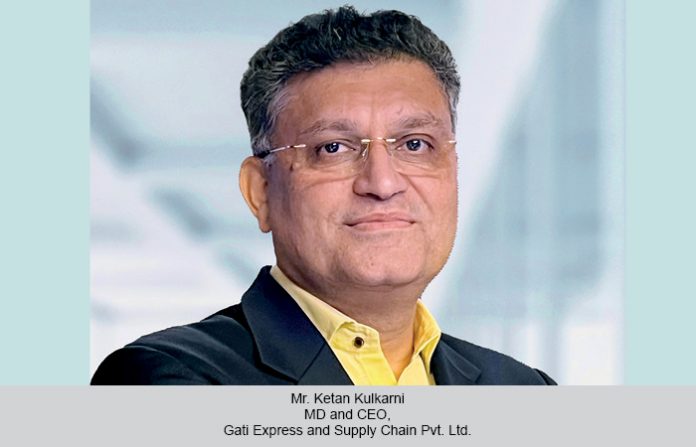The new 24-hour service will boost direct air deliveries, foster speed, agility and last-mile delivery covering pharma, perishables, e-commerce and electronics. But question remains if this service will benefit customers considering urban congestion, uneven infrastructure, unsupportive policies and lack of skilled workforce.
CT Bureau
Allcargo Gati recently announced its plans to expand its Air Express service to include direct air deliveries across eight metro cities such as Delhi, Mumbai, Ahmedabad, Pune, Kolkata, Hyderabad, Bengaluru and Chennai. For Indian logistics sector, it is a big development considering the market’s fragmented nature, uneven infrastructure, unskilled workforce and regulatory policies; same day deliveries have become quite a challenge.
This strategic move promises 24-hour deliveries, catering to the rising demand for time-critical shipments and seamless logistics across India’s economic hubs. Earlier this year, they launched direct Air Express services in Varanasi and Imphal, connecting tier II cities to the national supply chain grid.
time-sensitive goods
Ketan Kulkarni, Managing Director & Chief Executive Officer, Gati Express and Supply Chain, said the new 24-hour Air Express service is valuable for time-sensitive sectors such as pharmaceuticals, electronics and e-commerce, where faster and more reliable transit can significantly bring down stockouts and improve turnaround times (TATs).
Benefit for MSMEs
The new service will benefit MSMEs in expanding their market reach with quicker access to customers nationwide. Warehousing costs will go down as MSMEs will book warehouse space for only a couple of hours. The ability to offer 24×7 delivery drives stronger customer satisfaction and loyalty.
“Backed by connectivity to 34 commercial airports nationwide, the Air Express service supports high-volume logistics requirements across sectors such as pharmaceuticals, electronics, garments, automobile and retail, where speed and precision are crucial,” added Kulkarni.
Challenges galore
Same day delivery in India is a rapidly growing segment, fuelled by the rise of quick commerce platforms and the expansion of dark stores across tier I cities. Delhi, Mumbai and Bengaluru have witnessed an uptick in micro-fulfilment centres, allowing brands to respond quickly to consumer demands. This shift is reshaping the logistics landscape and presenting opportunities for growth and innovation.
However, there are crucial challenges to overcome—urban congestion can lead to delays, traffic jams, narrow lanes, accounting for a portion of delivery delays in busiest metros. The cost of building a same-day delivery network is high, requiring investment in multiple fulfilment centres, dedicated fleets and a robust air express network linking 34 airports across India. Last-mile delivery contributes to over half of total logistics costs. Also, India’s diverse geography and unpredictable weather conditions can affect service reliability, especially in remote areas.
multimodal infra
India’s multimodal infra is evolving at a fast pace, powered by initiatives such as PMGS, Bharatmala and NLP. Road transport, which handles 40 per cent of freight, continues to expand supporting faster road movement. Rail freight is also gaining momentum with DFCs and new terminals, though it still serves bulk cargo. Ports are becoming efficient and coastal shipping is growing, while inland waterways remain underutilised. “Although air cargo handles a smaller share of total volume, it plays a critical role in time-sensitive deliveries. While India’s multimodal logistics landscape is on an upward trajectory, greater integration, digitisation and first and last-mile connectivity is a must to unlock its full potential,” asserted Kulkarni.
transit times
“We are reducing transit times from days to hours—enabling faster market access for local traders, and MSMEs. This reduces delivery times, encourages business expansion and leaner operations. The ripple effect extends to smaller towns through our 99 per cent GDP coverage and integrating regional markets into national supply chain. In the long run, it encourages investments in local warehousing and logistics infrastructure. This as a key step toward making high-speed logistics accessible beyond metros, drives inclusive growth across the country,” Kulkarni said.
Advantages & disadvantages
The 24-hour service brings unmatched speed, high reliability and nationwide connectivity across 34 airports, making it a solution for pharma, electronics, fashion and e-commerce deliveries. “Seamless integration with our ground network ensures end-to-end delivery, enhancing efficiency for businesses. Air freight involves higher cost and has capacity constraints, making the service ideal for time-sensitive and high-value shipments. Weather or infra limitations at smaller airports can impact ops, but these can be mitigated with planning. For businesses prioritising speed and reliability, this service’s benefits far outweigh the challenges and it is a new trend other firms must follow,” he said.















